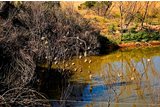Weaver species
Choose different species from drop-down list and press 'Go' button. See Full species list.Black-chinned Weaver Ploceus nigrimentus
IUCN: Least concern Discovery: 103Categories:
News items about species
Discovery
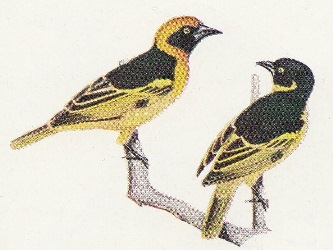
figure from Mackworth (1963) 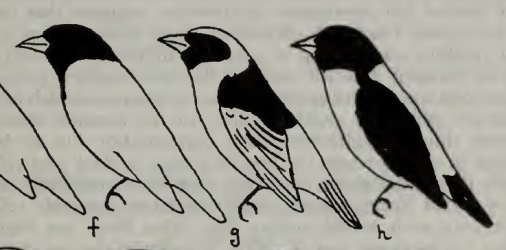
Weaver female (mid), Brown-capped Weaver (R), figure from Harrison (1965) 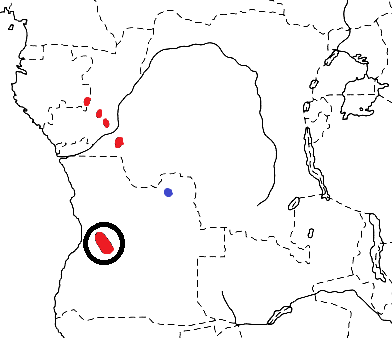
distribution, type locality circled (blue dot - new range) IntroductionThe Black-chinned Weaver was formally described by Anton Reichenow, a German ornithologist and herpetologist.The Black-chinned Weaver was collected by Jose Alberto de Oliveira Anchieta, a Portuguese explorer and naturalist. Anchieta moved to Angola with his family, in 1865. He lived in the region of Benguela, establishing a laboratory inside the ruins of a church, and exploring and collecting animals. In 1867, the Portuguese government hired him as a naturalist, but probably also as a secret agent in the Caconda region of Angola. He lived there, researching, exploring and sending many specimens and letters to his scientific correspondents in Lisbon, mainly J.V. Barboza du Bocage. Unfortunately most of the museum specimens have disappeared, as well as his many letters to Bocage, in a catastrophic fire in the Lisbon Museum in 1978. Anchieta collected 25 new species of mammals, 46 birds and 46 amphibians and ophidians. He did not write any scientific papers, but left this to his correspondents in Lisbon. Many of the species of birds, amphibians, lizards, snakes, fishes and mammals were named after Anchieta. Anchieta collected two female specimens of the Black-chinned Weaver, but the collection dates are unknown. The Black-chinned Weaver was first described in 1894 by Jose Vicente Barbosa du Bocage, a Portuguese zoologist and politician. He was curator of the Lisbon Museum. However, Bocage did not realise that he used an invalid name. Several years later, Reichenow realised this when he was working on his book on African birds. Reichenow provided a new name. The Black-chinned Weaver was first illustrated by Mackworth (1963), many decades after it was first described. The next illustration to be published was a line drawing in Harrison (1965), comparing the basic plumage patterns of several weavers. Scientific citationPloceus nigrimentus Reichenow 1904a, Vögel Afrikas 3 p.39, Galanga, Benguella, Angola.Meaning of namesnigrimentus, Latin: niger, black; mentum, the chin.First English nameBlack-chinned Weaver (Shelley 1905b).Alternate namesAngola Weaver.CollectorJose Alberto de Oliveira Anchieta.Date collectedBetween 1866-1895.Locality collectedGalanga, Benguella, Angola.Type specimensThe types were in the Lisbon Museum, but were lost in a fire. |
The above is based on Weaver Wednesday 2, a weekly series about the discovery of each weaver species.
This species text first appeared as
Weaver Wednesday [220] - Discovery [103]: Black-chinned Weaver on 2016-08-31
1. Basic biology
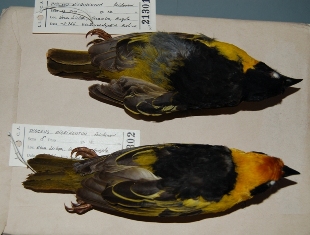
Lubango Collection 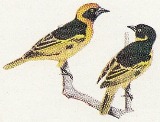
male left, figure from Mackworth (1963)
Distribution. The Black-chinned Weaver is known from south-east Gabon, central Congo-Brazzaville, western Democratic Republic of Congo, and the Bailundu highlands of central Angola (see red areas on map right, based on Birds of Africa). It is localised but not uncommon outside of Angola. It is very scarce in Angola and only ten specimens of this species are known from this country, including two in the Lubango Bird Skin Collection (see photo above left, and news). No subspecies of the Black-chinned Weaver are recognised. New sightings in recent years were reported from a new area - near Capaia in north-eastern Angola (dark blue circle on map). The global population has been estimated as at least 10000 pairs. Habitat. The Black-chinned Weaver inhabits open savanna with bushes and trees up to 8 m tall, often near gallery forest. It occurs in pairs or small groups but keeps to the tops of low trees. Food. Grass seeds and insects have been recorded as food items. Breeding. Breeding information was unpublished until recently (see news). The Black-chinned Weaver nests in small colonies, with up to ten nests in a single tree in Gabon. The nests are very large for weavers, woven mostly from coarse grass, giving a slightly untidy appearance. A collected nest was lined with finer grass, and had a ceiling (a layer of grass placed against the roof inside the main structure). The nest entrance is located on the side but near the top of the nest. The eggs and chicks, breeding season and other aspects of breeding biology of the Black-chinned Weaver are still unknown.
|
The above is based on Weaver Wednesday, a weekly series about weaver species.
This species text first appeared as
Weaver Wednesday [42]: Black-chinned Weaver on 2013-04-03
2. Breeding facts
| Pair bond no information Breeding season not recorded Nest site no information Nest building no information Colony size semi-colonial Clutch size no information Egg colour no information Egg size no information Incubation no information Chicks and nestling period no information |
Breeding information based on Handbook of the Birds of the World, Vol. 15.
3. Photos of Weaver Nests
 Vm 26200 |  Vm 5305 |  Vm 5304 |
Thumb-nails of most recent PHOWN records - click on one to see its full record
See all PHOWN records for this species here.
PHOWN (Photos of Weaver Nests) provides valuable info on breeding distribution and colony sizes of weavers.
You can contribute by registering and submitting photos at Virtual Museum webpage.
4. Breeding distribution
Google map showing distribution (For species with small ranges you need to zoom in at the correct area to see the range):
yellow blob - range of weaver species; read more about this here.
![]() - PHOWN records with photos
- PHOWN records with photos
![]() - PHOWN records with no photos (Nest Record Cards, other records)
- PHOWN records with no photos (Nest Record Cards, other records)
![]() - Birdpix records
- Birdpix records
![]() - comments on out of range records, or interesting records
- comments on out of range records, or interesting records
![]() - type locality
- type locality
CLICK on the marker on the map to see individual record details.
5. Range changes
Not South African speciesThe above is based on Weaver Wednesday 3, a weekly series about range changes in South African weaver species.
This species text first appeared as
n/a








